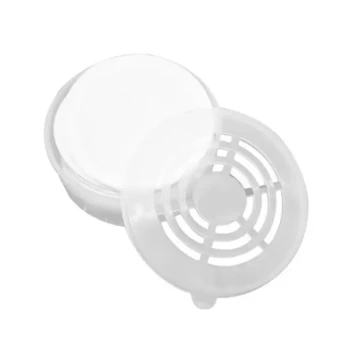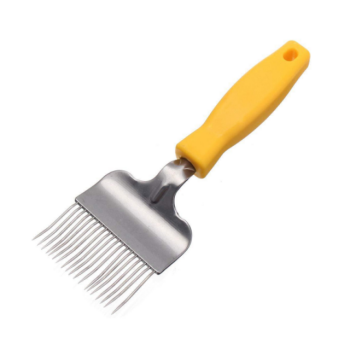To select the right beekeeping suit, you must evaluate three primary factors: the material's protective qualities, the design's comfort in your specific climate, and the functional features that ensure a secure barrier against stings. The ideal choice balances robust protection with breathability and ease of use for your beekeeping activities.
The core challenge in selecting a beekeeping suit is not finding the one with the most features, but rather the one that strikes the correct balance between protection and comfort for your environment and frequency of use.
The Foundation: Material and Construction
The material of your suit is the first line of defense. It dictates not only how well it prevents stings but also how comfortable you will be during hive inspections.
Choosing the Right Fabric
Most suits are made from cotton, polycotton blends, or synthetic mesh. Cotton is valued for its breathability, but it may offer less protection than thicker materials.
Polycotton blends provide a good middle ground, offering enhanced durability and protection while maintaining reasonable comfort.
Heavier fabrics naturally provide more protection, while lighter materials are more comfortable but may be more susceptible to stings.
The Role of Ventilation
For beekeepers in hotter climates, ventilated suits are a critical consideration. These suits often use a triple-mesh construction that allows air to circulate freely.
This design creates a significant air gap between you and the bees, providing excellent protection while dramatically reducing the risk of overheating.
Prioritizing Essential Protective Features
Beyond the base material, specific design elements are crucial for creating a bee-proof seal and ensuring your safety.
Securing All Entry Points
Effective beekeeping suits must have high-quality elastic at the ankles and wrists. This is a non-negotiable feature.
These elastic cuffs create a tight seal that prevents bees from crawling inside the suit, which is a common and dangerous point of entry.
The Importance of a Proper Veil
The hooded veil is an integral part of the suit, protecting your face and neck. It must offer clear visibility while ensuring no gaps exist where it joins the suit's collar.
Pre-Use Inspection is Crucial
Before every trip to your hives, you must inspect your suit for any holes or tears. Even a small opening can compromise the suit's integrity.
If any damage is found, repair it securely before use to ensure you remain fully protected.
Understanding the Trade-offs
Choosing a beekeeping suit involves navigating a key set of compromises. Understanding these will help you make a more informed decision.
Protection vs. Comfort
The most significant trade-off is between sting protection and comfort. Thicker, heavier materials offer more protection but retain more heat.
Conversely, lighter and more breathable suits are far more comfortable in warm weather but may offer slightly less defense against a determined sting.
Mobility and Fit
A beekeeping suit should always be slightly larger than your regular clothing size. You will be wearing it over your clothes.
A baggy fit serves two purposes: it allows for a full range of motion and creates a layer of air between the fabric and your skin, making it much harder for a bee's stinger to reach you.
Long-Term Use and Maintenance
A suit is an investment in your safety and a tool in hive management. Proper care is essential for its longevity and effectiveness.
Ease of Cleaning
Look for suits that are machine washable or have detachable components, such as the veil, for easier cleaning.
Why Cleaning Matters
Regularly cleaning your suit removes bee pheromones and hive debris. This practice helps prevent the potential spread of diseases between your colonies and extends the functional life of the suit itself.
Making the Right Choice for Your Needs
Your final decision should be guided by your specific goals and environment.
- If your primary focus is maximum protection in a cooler climate: A non-ventilated, thick polycotton suit provides the most robust physical barrier.
- If your primary focus is comfort during frequent inspections in a hot climate: A fully ventilated, triple-mesh suit is the superior choice to prevent overheating.
- If you are a hobbyist seeking a practical balance: A standard cotton or polycotton suit offers an excellent combination of protection, durability, and value for less frequent use.
Choosing the right suit transforms beekeeping from a potentially stressful task into a confident and enjoyable practice.
Summary Table:
| Key Selection Factor | Why It Matters | Key Consideration |
|---|---|---|
| Material & Construction | Determines sting protection and breathability. | Cotton, polycotton, or ventilated mesh for hot climates. |
| Essential Protective Features | Prevents bees from entering the suit. | Tight elastic cuffs at wrists/ankles and a secure, integrated veil. |
| Comfort & Fit | Impacts mobility and heat management during long inspections. | Choose a slightly loose fit for better air gap and movement. |
| Long-Term Maintenance | Ensures suit longevity and hive hygiene. | Prioritize machine-washable suits to remove pheromones and debris. |
Ready to Outfit Your Apiary with Confidence?
Choosing the right beekeeping suit is fundamental to safe and productive hive management. At HONESTBEE, we supply commercial apiaries and beekeeping equipment distributors with high-quality, durable suits designed for professional use. We understand the critical balance between maximum protection and all-day comfort.
Partner with HONESTBEE to equip your team with gear that delivers:
- Superior Protection: Durable materials and bee-proof seals for peace of mind.
- Optimal Comfort: Ventilated options to keep beekeepers cool and focused.
- Long-Term Value: Robust construction built to withstand frequent, demanding use.
Let's discuss your specific needs. Contact our wholesale team today to find the perfect beekeeping suits for your operation.
Related Products
- Cotton Folding Square Beekeeping Hat and Veil with Removable Mesh Bee-Proof Design
- Wholesales Dadant Size Wooden Bee Hives for Beekeeping
- Professional Insulated Plastic Bee Hives
- Long Langstroth Style Horizontal Top Bar Hive for Wholesale
- Professional Insulated Winter Hive Wrap for Beekeeping
People Also Ask
- What is the purpose of a hat and veil in beekeeping? Essential Protection for Head & Face
- Why is it important to close all zips and fasten buttons before washing a beekeeping suit? Protect Your Suit & Your Safety
- Why is it important to choose protective clothing with some freedom to move around? For Unrestricted Safety & Efficiency
- How does the design of the beekeeping hat ensure comfort during extended use? Maximize Comfort for Long Apiary Hours
- Which type of bee veil offers the best protection? Maximize Safety with Proper Space and Design



















